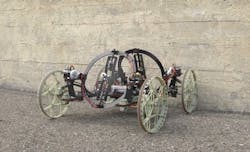Quartz recently released a video of a remote controlled, wall-climbing robotic vehicle (see the video below) built by Disney engineers with 3D printed components. Disney is reportedly calling the robot the VertiGo. In its report, Quartz says the Disney designers have not yet released much information about this robot, but note that it could be used for industrial inspections.
While the Quartz story is fascinating in its own right, I find it more interesting that this marks the second such wall-climbing robot I have encountered in the past six months.
During my visit last fall to Astec (a manufacturer of asphalt plants), Mark Chambers, controls director at Astec, mentioned that he and other engineers at the company had developed a “crawlerbot” that can be used to measure the density of asphalt silo walls. Chambers said the crawlerbot could eliminate the need for inspection scaffolding and sending workers up into the silo to take measurements manually.
He described the crawlerbot as a small, automated device—much like a remote controlled toy car—that uses brushless AC motors for propulsion and magnetized wheels to adhere to the walls of the silo. Outfitted with a camera, the crawlerbot allows staff on the ground to review images captured by the crawlerbot’s camera for density measurements.
Astec’s crawlerbot sounds a lot like the VertiGo to me, even though Chambers's description of the robot’s magnetized wheels is a clear differentiator from Disney’s approach to the concept.
You can read the full article detailing my visit to Astec and their use of automation here.
When you have engineers at companies as diverse as Disney and Astec working on wall-climbing robots for industrial applications, it’s safe to say we’ll be seeing lots more of these innovations in the near future.
Video of the VertiGo in action.

